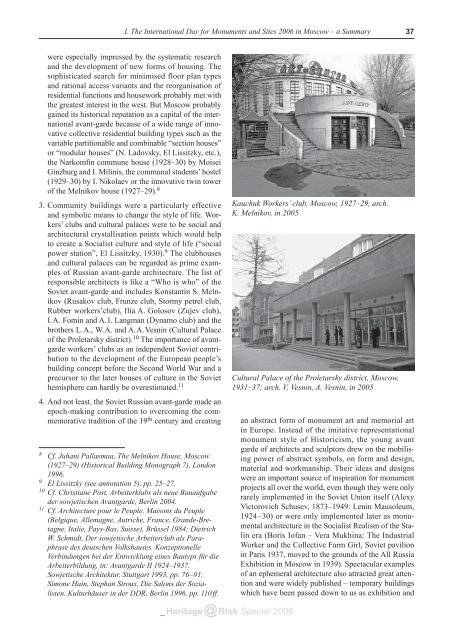The Soviet Heritage and European Modernism - Heritage ... - Icomos
The Soviet Heritage and European Modernism - Heritage ... - Icomos
The Soviet Heritage and European Modernism - Heritage ... - Icomos
You also want an ePaper? Increase the reach of your titles
YUMPU automatically turns print PDFs into web optimized ePapers that Google loves.
I. <strong>The</strong> International Day for Monuments <strong>and</strong> Sites 2006 in Moscow – a Summary<br />
37<br />
were especially impressed by the systematic research<br />
<strong>and</strong> the development of new forms of housing. <strong>The</strong><br />
sophisticated search for minimised floor plan types<br />
<strong>and</strong> rational access variants <strong>and</strong> the reorganisation of<br />
residential functions <strong>and</strong> housework probably met with<br />
the greatest interest in the west. But Moscow probably<br />
gained its historical reputation as a capital of the international<br />
avant-garde because of a wide range of innovative<br />
collective residential building types such as the<br />
variable partitionable <strong>and</strong> combinable “section houses”<br />
or “modular houses” (N. Ladovsky, El Lissitzky, etc.),<br />
the Narkomfin commune house (1928–30) by Moisei<br />
Ginzburg <strong>and</strong> I. Milinis, the communal students’ hostel<br />
(1929–30) by I. Nikolaev or the innovative twin tower<br />
of the Melnikov house (1927–29). 8<br />
3. Community buildings were a particularly effective<br />
<strong>and</strong> symbolic means to change the style of life. Workers’<br />
clubs <strong>and</strong> cultural palaces were to be social <strong>and</strong><br />
architectural crystallisation points which would help<br />
to create a Socialist culture <strong>and</strong> style of life (“social<br />
power station”, El Lissitzky, 1930). 9 <strong>The</strong> clubhouses<br />
<strong>and</strong> cultural palaces can be regarded as prime examples<br />
of Russian avant-garde architecture. <strong>The</strong> list of<br />
responsible architects is like a “Who is who” of the<br />
<strong>Soviet</strong> avant-garde <strong>and</strong> includes Konstantin S. Melnikov<br />
(Rusakov club, Frunze club, Stormy petrel club,<br />
Rubber workers’club), Ilia A. Golosov (Zujev club),<br />
I. A. Fomin <strong>and</strong> A. I. Langman (Dynamo club) <strong>and</strong> the<br />
brothers L. A., W. A. <strong>and</strong> A. A. Vesnin (Cultural Palace<br />
of the Proletarsky district). 10 <strong>The</strong> importance of avantgarde<br />
workers’ clubs as an independent <strong>Soviet</strong> contribution<br />
to the development of the <strong>European</strong> people’s<br />
building concept before the Second World War <strong>and</strong> a<br />
precursor to the later houses of culture in the <strong>Soviet</strong><br />
hemisphere can hardly be overestimated. 11<br />
4. And not least, the <strong>Soviet</strong> Russian avant-garde made an<br />
epoch-making contribution to overcoming the commemorative<br />
tradition of the 19 th century <strong>and</strong> creating<br />
8<br />
Cf. Juhani Pallasmaa, <strong>The</strong> Melnikov House, Moscow<br />
(1927–29) (Historical Building Monograph 7), London<br />
1996.<br />
9<br />
El Lissitzky (see annotation 5), pp. 25–27.<br />
10<br />
Cf. Christiane Post, Arbeiterklubs als neue Bauaufgabe<br />
der sowjetischen Avantgarde, Berlin 2004.<br />
11<br />
Cf. Architecture pour le Peuple. Maisons du Peuple<br />
(Belgique, Allemagne, Autriche, France, Gr<strong>and</strong>e-Bretagne,<br />
Italie, Pays-Bas, Suisse), Brüssel 1984; Dietrich<br />
W. Schmidt, Der sowjetische Arbeiterclub als Paraphrase<br />
des deutschen Volkshauses. Konzeptionelle<br />
Verbindungen bei der Entwicklung eines Bautyps für die<br />
Arbeiterbildung, in: Avantgarde II 1924–1937.<br />
Sowjetische Architektur, Stuttgart 1993, pp. 76 –91;<br />
Simone Hain, Stephan Stroux, Die Salons der Sozialisten.<br />
Kulturhäuser in der DDR, Berlin 1996, pp. 110 ff.<br />
Kauchuk Workers’ club, Moscow, 1927–29, arch.<br />
K. Melnikov, in 2005<br />
Cultural Palace of the Proletarsky district, Moscow,<br />
1931–37; arch. V. Vesnin, A. Vesnin, in 2005<br />
an abstract form of monument art <strong>and</strong> memorial art<br />
in Europe. Instead of the imitative representational<br />
monument style of Historicism, the young avant<br />
garde of architects <strong>and</strong> sculptors drew on the mobilising<br />
power of abstract symbols, on form <strong>and</strong> design,<br />
material <strong>and</strong> workmanship. <strong>The</strong>ir ideas <strong>and</strong> designs<br />
were an important source of inspiration for monument<br />
projects all over the world, even though they were only<br />
rarely implemented in the <strong>Soviet</strong> Union itself (Alexy<br />
Victorovich Schusev, 1873–1949: Lenin Mausoleum,<br />
1924 –30) or were only implemented later as monumental<br />
architecture in the Socialist Realism of the Stalin<br />
era (Boris Iofan – Vera Mukhina: <strong>The</strong> Industrial<br />
Worker <strong>and</strong> the Collective Farm Girl, <strong>Soviet</strong> pavilion<br />
in Paris 1937, moved to the grounds of the All Russia<br />
Exhibition in Moscow in 1939). Spectacular examples<br />
of an ephemeral architecture also attracted great attention<br />
<strong>and</strong> were widely published – temporary buildings<br />
which have been passed down to us as exhibition <strong>and</strong><br />
_ <strong>Heritage</strong> @ Risk Special 2006

















